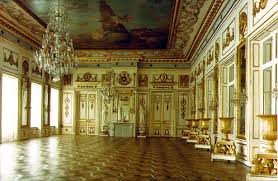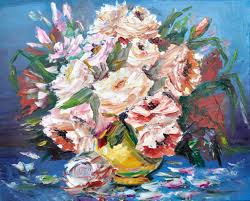ART UNIONS AND CREATIVE UNIONS OF RUSSIA ON THE TURN OF THE XIX-XX CENTURIES (part 1)
 Abramtsevsky (Mamontovsky) art circle – the so-called Representatives of the creative intelligentsia, mainly Moscow, united around the famous businessman and philanthropist S.I. Mamontov. Meetings and meetings of artists and art lovers took place in Mamontov’s house on Spassko-Sadovaya Street, and in the summer, in the Abramtsevo estate near Moscow near Sergiev Posad. Mamontov financially helped artists, supported them with many creative endeavors. The circle existed in 1878-93, while it was never an official society or an art group. Artists often came to Abramtsevo for the whole summer with their families. Here they could work and communicate. In the Abramtsevo circle, the study of Russian history and culture was combined with the desire to revive the traditions of folk art. The estate organized workshops for the revival of ancient art crafts (wood carving, majolica, sewing). In the Abramtsev park, buildings were erected in the “Russian style” – “Terem” (I. P. Roneta, 1873), a church and the “Hut on Chicken Legs” (designed by V. M. Vasnetsov, 1881-83). Amateur performances have become one of the most famous endeavors of the Mamontov circle. Starting from 1878, they were placed every season: in winter – in a mansion on Spasskaya-Sadovaya, in summer – in Abramtsevo. The scenery, costumes, posters and programs for them were created by the artists themselves, and they were often also role performers. The most successful production of the Mamontov circle is considered to be “The Snow Maiden” by A. N. Ostrovsky, shown in 1882. These performances greatly contributed to the appearance in the 1890s. Moscow private Russian opera. The Abramtsevo circle included M. M. Antokolsky, A. M. and V. M. Vasnetsov, M. V. Vrubel, K. A. and S. A. Korokin, I. I. Levitan, M. V. Nesterov, I. S. Ostroukhov, V. D. and E. D. Polenov, N. A. Rimsky-Korsakov, V. A. Serov, K. S. Stanislavsky, M. V. Yakunchikova and others.
Abramtsevsky (Mamontovsky) art circle – the so-called Representatives of the creative intelligentsia, mainly Moscow, united around the famous businessman and philanthropist S.I. Mamontov. Meetings and meetings of artists and art lovers took place in Mamontov’s house on Spassko-Sadovaya Street, and in the summer, in the Abramtsevo estate near Moscow near Sergiev Posad. Mamontov financially helped artists, supported them with many creative endeavors. The circle existed in 1878-93, while it was never an official society or an art group. Artists often came to Abramtsevo for the whole summer with their families. Here they could work and communicate. In the Abramtsevo circle, the study of Russian history and culture was combined with the desire to revive the traditions of folk art. The estate organized workshops for the revival of ancient art crafts (wood carving, majolica, sewing). In the Abramtsev park, buildings were erected in the “Russian style” – “Terem” (I. P. Roneta, 1873), a church and the “Hut on Chicken Legs” (designed by V. M. Vasnetsov, 1881-83). Amateur performances have become one of the most famous endeavors of the Mamontov circle. Starting from 1878, they were placed every season: in winter – in a mansion on Spasskaya-Sadovaya, in summer – in Abramtsevo. The scenery, costumes, posters and programs for them were created by the artists themselves, and they were often also role performers. The most successful production of the Mamontov circle is considered to be “The Snow Maiden” by A. N. Ostrovsky, shown in 1882. These performances greatly contributed to the appearance in the 1890s. Moscow private Russian opera. The Abramtsevo circle included M. M. Antokolsky, A. M. and V. M. Vasnetsov, M. V. Vrubel, K. A. and S. A. Korokin, I. I. Levitan, M. V. Nesterov, I. S. Ostroukhov, V. D. and E. D. Polenov, N. A. Rimsky-Korsakov, V. A. Serov, K. S. Stanislavsky, M. V. Yakunchikova and others.
“Abstraction-Creation” – an international union of abstract artists, founded in February 1931 at the initiative of the Belgian sculptor and painter Van Duisburg. The objectives of the association were the comprehension of the experience of abstract art and its popularization. The Union “Abstraction-Creation” included about four hundred members. The creativity of these artists represented various trends in abstract art. In the years 1932-36. a magazine was published under the same name. The union broke up in the 1940s.
“Scarlet Rose” is an association of Moscow painters of a symbolic direction. At the head were the natives of the city of Saratov P.V. Kuznetsov and P.S. Utkin. The first exhibition was held in May-June 1904 in Saratov at the initiative of students of MUZHVZ. The works of E.V. Aleksandrov, A.A. Arapov, M.V. Volgin (Kuznetsov), I.A. Knabe, P.V. Kuznetsov, N.N. Nordossky, V.P. Polovinkin, E. S. Potekhina, N. N. Sapunova, M. S. Saryana, S. D. Simpol, S. Yu. Sudeikina, P. S. Utkina, K. L. Felden, N. P. Feofilaktova. As honorary exhibitors were invited M. A. Vrubel and V. E. Borisov-Musatov. Works made in the technique of majolica in Abramtsevo workshops were also exhibited. Since 1905, members of the group took part in MTX exhibitions and collaborated in the organ of the Moscow Symbolists – the Libra magazine. In 1907, they formed the core of a new group – “Blue Rose”, where they continued to develop the symbolist trend and principles of decorativeism in painting.
The Artel of Artists (St. Petersburg Artel of Artists) is an association founded in 1863 by young artists participating in the “riot of fourteen” who left the Academy of Arts and refused to write on given programs. These included B. B. Venig, A. K. Grigoriev, N. D. Dmitriev-Orenburg, F. S. Zhuravlev, A. I. Korzukhin, I. N. Kramskoy, K. V. Lemokh, A. D. Litovchenko, A. I. Morozov, M. I. Peskov, N. P. Petrov and N. S. Shustov. Artists settled all together on Vasilyevsky Island, conducted a common household and were engaged in creativity. In 1865, the Charter of the Artel was approved, according to which its members jointly carried out various art orders, and shared the fee among themselves. A certain part of the funds went into the “common boiler”. There were also percentages of individual orders. All questions of creativity were decided by the artisans together. In fact, it was a form of labor commune. Artel also engaged in the organization of exhibitions. On Thursdays, artel’s drawing nights took place, which attracted the St. Petersburg intelligentsia and creative youth. The association of artists was short-lived. After leaving the Artel in 1870, I.N. Kramskoy, she soon ceased to exist. Artel members took an active part in TPHV.



